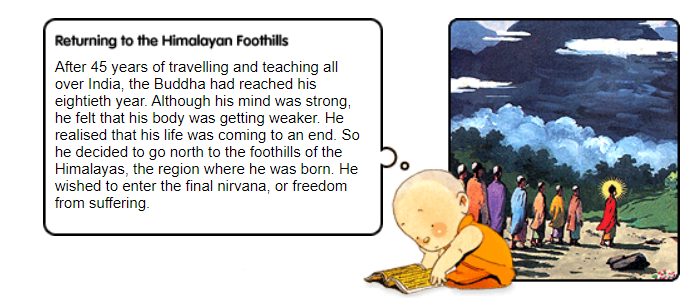
In this unit: Even enlightened beings don’t live forever. In his eightieth year, the Buddha returned to his birthplace to die. His disciples were devastated, and pleaded with him not to leave. They didn’t think they could manage without their teacher. But the Buddha explained that his teachings are the teacher and practicing these is what keeps the Dharma alive.

The Buddha Speaks of His Death
On the journey, the Buddha was offered a meal of mushrooms by Cunda, the son of a goldsmith. He became ill after the meal, but insisted on continuing as far as Kusinara. Ananada, his faithful attendant, wept to see the Buddha so ill. The Buddha comforted him saying, “Do not grieve, Ananda. I am old and feeble and cannot live forever. It is natural for everything that is born to die. In three months I shall pass away into final Nirvana, a state of ultimate peace and happiness. Call all the monks and nuns together.”
The disciples wept and begged their teacher to remain in the world. With tears in his eyes, Ananda asked, “When the Buddha is no longer in the world, who is there to teach us?”
“What more is there to teach, Ananda?” The Buddha asked. “I have taught you all I know, there is nothing that I have kept hidden. My teachings are your teacher now. Follow them and you will be true to me.”
In a sala grove near Kusinara, the Buddha humbly said, “I can go no further Ananda, prepare a resting place for me between these two large sala trees.” He lied down on his right side with his head to the north. The two sala trees bloomed out of season and rained blossoms all around him.
The Last Respects
Hearing that the Buddha was dying, people came from afar to pay their last visit. Even as he lay there in pain, he continued to teach until his last moment.
At dusk when the grove was cast in purple shadows, the Buddha entered into final Nirvana. Before departing, he spoke his last words. “Everything is subject to change. Remember to practise the teachings earnestly.”
All his disciples and villages gathered around him and wept. According to custom, his body was placed on a pyre and burned. Shining, jewel-like relics were found in the ashes. They were divided into eight parts and placed in monuments called stupas.
The Buddha passed away in 543 BC. Since then his teachings of compassion and wisdom have been passed on from generation to generation, from country to country, and from heart to heart, right up to the present day.

The Stupa
Stupas are mounds that were built to hold relics of the Buddha or his chief students. They were also built to mark important events of the Buddha’s life or lives of his disciples. King Ashoka is said to have built 84,000 stupas all over India, from the original relics of the Buddha. In Sri Lanka stupas are called dagobas; in Myanmar, Thailand and China they are know as pagodas and in Tibet they are called chortens.

This diagram shows the different shapes of stupas or pagodas, while the coloured diagram explains the symbolic levels in the stupas, representing the four primary elements: earth, water, fire, wind and the space element.
Activity Box

- Creating Vesak Gifts: Make your own Vesak or Buddha Day gifts.
- A Buddhist Tale to Read & Discuss: “Demons in the Desert” [The Correct Way of Thinking].
- Guided Meditations: Seven guided meditations, with instructions for teachers.
- Buddhist Songs: Seven audio files (MP3 format), with lyrics.
- Colouring in Buddhist flag (eBook Library)
- Colouring in Buddha & Bodhi leaf (eBook Library)

